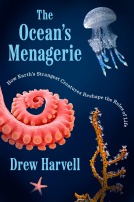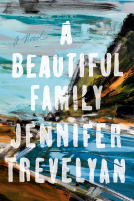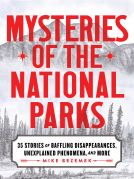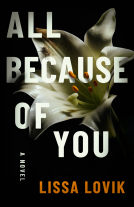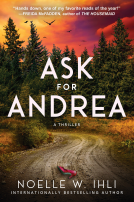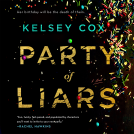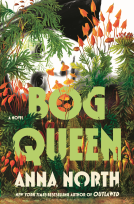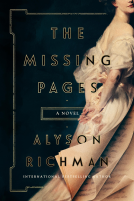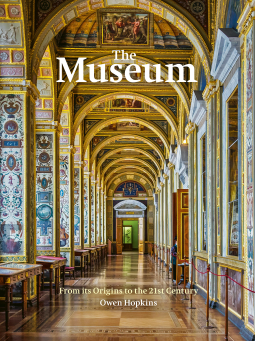
The Museum
From its Origins to the 21st Century
by Owen Hopkins
This title was previously available on NetGalley and is now archived.
Send NetGalley books directly to your Kindle or Kindle app
1
To read on a Kindle or Kindle app, please add kindle@netgalley.com as an approved email address to receive files in your Amazon account. Click here for step-by-step instructions.
2
Also find your Kindle email address within your Amazon account, and enter it here.
Pub Date Nov 23 2021 | Archive Date Dec 16 2021
Quarto Publishing Group – White Lion | Frances Lincoln
Talking about this book? Use #TheMuseum #NetGalley. More hashtag tips!
Description
Visited by millions around the world every year, museums are one of mankind’s most essential creations. They tell stories, shape cultural identities and hold valuable insight about the past and about the future. This captivating works charts a path from the very first collection through to the latest developments in cultural curation, interweaving
Using examples of the greatest cultural institutions to shape the narrative, historian and academic Owen Hopkins draws on his deep knowledge of the field to outline the history of the museum movement.
Tracking the evolution from princely collections in Europe and the Enlightenment’s classically inspired temples of curiosities, via the public museums of the late nineteenth century, on to today’s global era oficonic buildings designed by the world’s leading architects, this book is a vital work for anyone seeking to understand the development of the museum into what it is today.
Over the course of five chapters filled with stunning imagery that highlights the beauty of these venerated buildings, the origins of key institutions are revealed, including:
- Louvre
- Metropolitan Museum of Art
- British Museum
- Tate Modern
- The Hermitage
- Guggenheim
- Smithsonian Institute
- Acropolis Museum
Also outlined are the motivations of the architects, curators and patrons who have shaped how we experience the modern museum, a cast that includes names such as King George II, Napoleon, Henry Clay Frick, Peggy Guggenheim, Andrew Carnegie, Alfred Barr, Frank Lloyd Wright, Le Corbusier, Frank Gehry, Richard Rogers, Nicholas Serota and Zaha Hadid.
By examining how these venues became intrinsic to our shared cultural experience, analysing the changing roles they play in society and questioning what the future holds in a digital age, this book is for anyone who has stood in awe at the spectacle of a museum.
Available Editions
| EDITION | Other Format |
| ISBN | 9780711254565 |
| PRICE | $60.00 (USD) |
| PAGES | 320 |
Featured Reviews
The Museum is a remarkably immersive experience, very enjoyable and informative. Photographs and prints cannot get more stunning than those contained here, so life like and glossy. Museums in various forms throughout history have been created and curated as people such as Pliny recognized the importance of cataloguing and labeling collections. These collections eventually became what is known today as museums, housed for various reasons including education and storing valuables. Museums are not only art collections but contain curiosities, relics, reliquaries, rarities and gems. Amongst the most unusual I have been to are the Museum of Broken Relationships in Zagreb and a local display of animal oddities.
Author Owen Hopkins highlights the origin of the word "museum", the Enlightenment Gallery, Elgin Marbles and history of well-known museums (Capitoline and Vatican Museums in Rome, the Library of Alexandria in Egypt, Metro Museum of Art in America, Uffizi Gallery in Florence, Crystal Palace in Hyde Park, the Iraq Museum, etc.). He describes treasuries and pilgrimages, natural vs. man-made contents, inception of public display, architecture and purpose-built buildings, cubism, art in WWII (plundering/hiding, too), modern trends (Louvre Abu Dhabi in the UAE looks breathtaking!), the mindful choice of Asian museums doing as they like rather than conforming to Western standards and the effects of smart phones.
One of my favourite prints in the book is the frontispiece of the Museum Wormianum. Another is The Sense of Sight. Both works to me sums up "museum" perfectly. I am grateful to have been to many museums in this book and have learned so much. This outstanding book has inspired me to research others which are now on my list.
Whether you are a museum fan or not, you will most certainly enjoy learning about the history of museums and ogling the otherworldly photography. In my opinion this book is unmissable.
My sincere thank you to Quarto Publishing Group - White Lion and NetGalley for the privilege of reading this downright splendid book!
 Rosemary S, Librarian
Rosemary S, Librarian
Much like libraries, museums are our repositories for knowledge, a record of who we were, who we are and where we are going. Also like libraries, museums are in constant danger of closing due to lack of funding. Hopkins showcases our museums, from their early days as private to collections to the vast repositories like the Smithsonian Institution. Fascinating and important.
The photography in this book is absolutely stunning! Dozens of museums are vividly featured in big, lush pictures that lovingly capture their unique architectural detail and style. Even without reading a word of the insightful, informative text, this book is well worth looking through!
I enjoyed the organization of the book by historical context/school of thought that inspired each museum rather than something as simple as geographical area. That structure made it easier to compare and relate museums of similar eras for how they reflected their time. It was impossible not to notice that the collection of museums featured was very Eurocentric (and, specifically, quite Anglocentric). It was really only in the last 20% of the book that any significant mention of Asian or African museums was made.
That said, this was still a fascinating read and it would be thoroughly enjoyed by architecture buffs, armchair travelers, and amateur historians as well as people who enjoy museums.
Many thanks to the publisher and NetGalley for the opportunity to read and review!
 Reviewer 34846
Reviewer 34846
Excellent ! Informative and the photos are georgous !
A must read for those who loved the recent tv programs ,"Secrets of the Museum Inside the V&A" and "Amearicas Treasure Houses :The MET".
I love art museums. For a whole semester in college I was an art history major and my dream job in another life is to do art restoration for a museum. I have been to many of the best museums in the world and have a bucket list of museums I still want to visit. In short, this book was made for me.
This book provides a comprehensive history of museums. It examines how they came to be and the transition from elite collections to public institutions. It discusses the theory behind museums and how their collected and curated. While much of the focus of the book is on Europe, it does also examine museums in Asia, North America, South America, and Africa. I was very impressed by the fact that the book openly acknowledges the controversies in the museum community like colonialism, repatriation, the slave trade, etc. and discusses how museums can be very political. One of my favorite things in this book was the historical photographs, especially those of museums I’ve been to. I loved seeing the galleries of the V&A being built and the Vanderbilt mansion where the New York MoMa currently is.
Overall I really enjoyed this book and it would make a wonderful addition to any art lover’s collection. Thank you to NetGalley and Frances Lincoln for the ARC.
This book proved a fascinating look at museums--both historical and present-day! I learned so much, and especially enjoyed seeing then-and-now pictures of museums I've visited, documenting how they've changed over the years. The extensive commentary provided plenty of insight into the whys and wherefores, as well.
As the covid pandemic continues, so does my appreciation for books such as this one, which acknowledge the weird/crazy/abnormal (I don't want to include the overused "u" word, lol) times we live in--and also remind us of what has been, and what will be again. It's all too easy to get pandemic-induced tunnel vision and forget what life looked like outside covid; as I look ahead to the future and consider how I want my own life to look afterwards, this read provided surprising insight into that inner dialogue.
I also enjoyed seeing pictures of museums I'm unlikely to visit in person (even pandemic aside); while the interest level (or travel advisories) may preclude a "live" visit, I can still learn from reading about them! (Plus, how cool is it that Nashville has a Parthenon replica with a 42-foot statue of Athena?! I had no idea--and would love to see it!)
The last section of the book provides a thought-provoking read on colonialism and repatriation. Certainly there isn't a quick, easy, or "pat" solution/response, nor is this section comprehensive in its examination of either. Channeling George Santayana (a Spanish philosopher) and Winston Churchill: “Those who cannot remember the past are condemned to repeat it,” and “Those that fail to learn from history are doomed to repeat it.” These quotes drive me and, I hope, others in the dialogue.
I received an eARC of the book from the publisher via NetGalley. All opinions are my own.
Pros: I loved this book’s examination of museums, especially the discussion of the architecture of the structures that house the collections and of the emergence of post-national museums. Also, the photographs throughout this book are fantastic and inspire travel.
Although this book is very much a love letter to museums, the author also offers nuanced critiques. What I appreciated most about this book is that in the preface (and then more in depth in the final chapter), the author notes the importance of what museums choose to feature and exclude and how many museums are (or should be) working to be more inclusive and diverse. I also appreciated the author’s alluding to the ethics of how some collections came to be, e.g., as a result of colonization, conquest, and “culturally informed plunder.” Further, this book is not Eurocentric and features museums across the world.
Cons: This isn’t a con of the content of the book but more of a note about the reading experience: The photographs in this book are lovely, so I suggest reading a physical copy of this book rather than an ebook version.
Thank you to NetGalley and Quarto Publishing Group – White Lion for the opportunity to read this book
I’ve shared this review on Goodreads and StoryGraph.
 Melissa J, Librarian
Melissa J, Librarian
The glossy pictures of museums from all over the world, combined with the interesting and insightful text which charts the development of museums, makes this book a must for anyone who loves museums.
I especially enjoyed the chapter on museums during the Enlightenment, as I find this period of history fascinating. I also think that the book does a great job addressing the role that museums have played (and sometimes still play) in promoting colonialism and the debates around repatriating items taken during wars or colonial expansion. These topics were dealt with in a respectful and thought-provoking way.
This book has definitely sparked my desire to travel again, and I've now got a list of museums I'd like to visit!
This book is one to linger over as so much is included within its pages. In addition, the illustrations provide some wonderful escapism as readers can travel to some of the world’s best known buildings, collections and galleries; those are the museums of the title.
It is clear that the author of this volume has researched and thought deeply. Within the first few pages of the text, there is mention of Covid and the state of race relations in the U.S. This is all incorporated into a deep dive of the focus and role of the museum, a cherished and, at times, challenging institution. Attention is paid to the history of the museum in its many manifestations. Chapter headings include Origins, The Enlightenment Museum, The Public Museum, The Modern Museum, The Global Museum and, The Museum NOw. The end of the book includes suggestions for additional reading.
This book can be enjoyed by those who have taken art history classes or those looking to learn more about museums even as museum novices. It is worth a look!
Many thanks to NetGalley and the publisher. All opinions are my own.
 Reviewer 774126
Reviewer 774126
This book is a really interesting read but to be honest, it's the photography in it that steals the show. It's so beautiful. I requested it wanting to see if it might make a suitable gift for my mother. I'm sure she'd love it but I might be buying a copy for myself as well. Even if you aren't that interested in museums, it's worth looking at for the architecture. Am adding a huge number of places to my holiday wishlist as a result of this book. Thanks for the ARC.
 Rae H, Librarian
Rae H, Librarian
Owen Hopkins does not disappoint with The Museum. Every page is filled to the brim with information the world over and gorgeous photos of temples, museums, libraries, and other historical sites. This book is a perfect coffee table gift book.
I am a firm supporter and lover of museums. I have planned entire vacations around getting to certain museums. And in my travels I've stumbled fabulous ones I didn't know existed. This book celebrates museums. The photos are fabulous and although they are plentiful I still would gladly have welcomed more. The book is broken into sections covering: Origins; Enlightenment Museum, Public Museum, Modern Museum, and the Museum Now. Some museums are filled with what once were the royal treasures while other started as collections of curiosities gathered by those that had the money and interest. The Smithsonian in the US was planned to collect and celebrate America. The book takes time to explain the differences in the museums and what they reflect. It doesn't shy away from controversies such as collections that come from colonialism, or as a result of spoils of war. The controversies of repatriation are discussed too. There is a primary focus on Europe but in the later sections it adds museums from North America, South America and Asia. I have been to most of the museums featured in the USA and Europe and look forward to future travels when I hope to get to museums on other continents. This is not a travel guide and it doesn't promote specific museums. But instead uses select museums or their collections as part of topics under discussion. I like that the book talks about displays, curation and purpose which is as important as the collections themselves. I think if I had one criticism it is that the writing is very intellectual and may be difficult for a casual reader. This is a great coffee table book and again the photos are the stars. Thank you to NetGalley and Quarto Publishing Group - White Lion for a temporary eARC in exchange for an honest review.
 Educator 901032
Educator 901032
This tome delves into the origins, evolution, and architecture of several key museums from around the globe. From cabinets of curiosities and expressions of power to architectural marvels and showcases of culture and social injustice. By no means an exhaustive list, the author does a great job of including several new museums from around the globe in the final two chapters. Stunning photographs add to the depth of this work. Index makes finding specific examples and artists a breeze and further reading list provides insights for those still left hungry for more knowledge.
This beautiful book transports the reader to crowd-free/reduced-crowd locations that will inspire you to visit remarkable museums, castles, and archeological sites around the world from the comfort of your reading nook. ‘The Museum’ explores the intricacies of museums, such as acquiring antiquities and plunder, as well as the preservation of priceless works of art during the world wars, and topics on repatriation, proving that beauty is rarely conflict-free.
 Allyson H, Reviewer
Allyson H, Reviewer
The Museum provides a useful survey of the history of museums, supplemented by a wealth of excellent photography that enriches the text and would make this a great coffee table book. Hopkins discusses a wide variety of museums and brings in extremely current, relevant issues.
This book is probably best for readers new to the history of museums and collecting; since I already knew quite a bit, there wasn’t much until the last couple of chapters that was truly new to me.
It seems to me that some of the assertions made in the book--mostly in the Introduction and the final chapter--need more explanation or unpacking, such as the idea that museums “embody architecture at its most fundamental,” or the idea raised in relation to the Capitoline collection in Chapter 1 that a museum *needs* a museum building, or the idea expressed in the final chapter that the object is not central to the museum, based on three defining characteristics set out by the author.
Despite an insistence on the importance of architecture to a museum, the book seems to treat museum architecture rather unevenly, discussing newer museums’ architectural innovation at much greater length than the architectural developments of museums before the modern age.
Quibbles with the text aside, this book would make a great addition to an art lover’s library or as part of the reading for an undergraduate survey course introducing museum studies. Its extensive inclusion of non-Western museums is especially welcome in a field that often lingers on storied European and American institutions.


